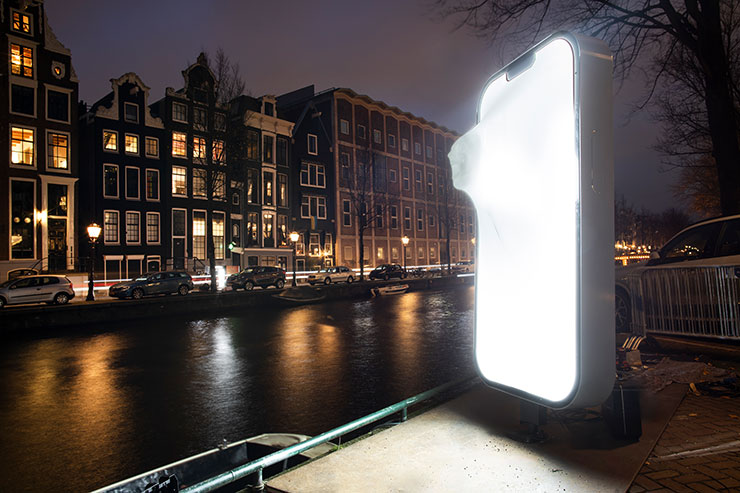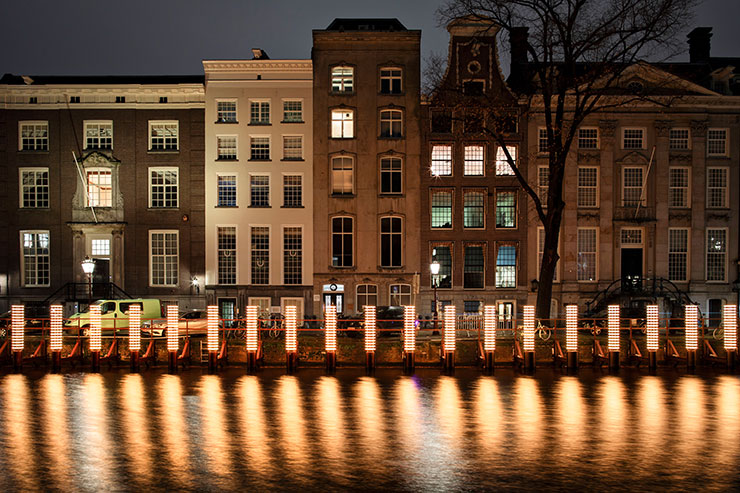- ABOUT
- JUDGING
- CONTACT
- MORE
- 2024 Entries
- Installations 2024
- Past Winners
- Subscribe
- [d]arc directory
- arc magazine
- darc magazine
Amsterdam Light Festival Edition 12, Netherlands
EventAmsterdam Light Festival Edition 12LocationAmsterdam, NetherlandsOrganiserAmsterdam Light Festival FoundationMain PartnersGemeente Amsterdam | VU Amsterdam | VriendenLoterij | Amsterdam First Class Hotels | Mondriaan Fonds | University of Amsterdam | Stichting Gouden Dagen | VolkerWessels | Light Art Collection | Capital C AmsterdamMain SponsorsOver 60 sponsors
Amsterdam Light Festival is an annual festival, organised by the Amsterdam Light Festival Foundation, which has a Public Benefit Status (‘culturele ANBI stichting’). The festival receives little subsidy and funds, and is therefore largely funded by collaborative partners and sponsors. Each year, a new festival edition is organized for residents and visitors of the city, with an art route along the iconic, historic canals of Amsterdam. The route can be enjoyed by boat and on foot with memorable storytelling experiences. Each new edition has a different theme, which revolves around contemporary and societal issues.
Since the beginning of the festival in 2012, the festival has had a unique approach in commissioning artworks and collaborating with the artists, called ‘co-creation process’. About 2 years prior to the exhibition, the festival sets out a worldwide Open Call, during which creatives from all over the world can submit a concept for the festival. From professional light designers, to architects, sculptors and photographers; anyone with an illuminating idea can participate, resulting in a selection of diverse and bespoke light artworks each year. After a careful review process – by an independent international jury and the festival’s technical team – the selected artists are invited to Amsterdam for the kick-off of the projects, where they get to meet the festival team, experience the festival in exhibition and learn about possible locations on the route. From there on, the artworks are financed by the festival and produced in collaboration with the artists. During the festival, over 100 volunteers help out to make the festival happen. When the festival is over, many of the artworks become part of the internationally travelling Light Art Collection, so the artworks premiered in Amsterdam can be admired by audiences all over the world.
For the 12th edition of the festival, which took place from 30 November 2023 until 21 January 2024, the festival asked artists to consider the effects of technology and artificial intelligence (AI) in our everyday lives. The ways in which we communicate, engage and create are all influenced by technology and AI. The festival examined the pressing questions with the audience and the artists; what is the impact on the human condition? How does society change because of this digital evolution? And where are their boundaries? 24 artworks were exhibited and experienced in the public space of Amsterdam in the theme, LOADING… Revealing Art, AI and Tech.
Most of this year’s light artworks were produced through the co-creation process of the festival. The artworks presented a broad range of lighting technologies and most current AI technologies, highlighting different aspects of the theme. For instance, the public’s favourite Artificial Humans by Belgian design duo Atelier Haute Cuisine, was entirely based on an image created by AI image generator DALL·E 2. The result is a series of illuminated ‘humans’, looking unaware of the surroundings, hunched over and weighed down. The ‘humans’ are cast from optic fibre and resin and are molded to the bodies of the artists, which represented the collaboration between AI and human in the creative process. Another example could be the work Error by Dutch artist duo Vendel & De Wolf, comprised of a 14 meters high steel frame, with what looks like a blue, revolving vortex. The most unusual swirling effect is ironically created by using ready-made conventional Christmas lights, a signature of the artists. Others, such as the Indian artist Vibhor Sogani, created an ethereal utopian future landscape with a multiplicity of distorted reality within a pool of mirrored orbs. The high grade stainless steel spheres are custom made, carefully polished and placed on the quay side and in the water. Inside the sphere is a mysterious blue light, giving a dreamlike presence to the environment around them.
Other techniques and mediums employed by the participating artists include photography and light boxes, pixelated interactive shadow play, interactive theatrical display of avatars using kinect, endless variation of chromatic algorithm in projection techniques and interactive sculptural works.
With the foundation’s mission to connect and enrich people through the universal language of light (art), the 12th edition of Amsterdam Light Festival has proven to be a huge success. Not only did the festival welcome 1 million visitors, but more people than ever were reached through its online channels. Next to that, the yearly-recurring educational project has grown to 1500 students of 10-12 y/o participants this year, during which they learned about light art and become part of a large scale cultural event in their own city. Through a series of workshops that were organized and hosted by the festival, they make a physical contribution to a light artwork on the route, which all 1500 children with their parents/caregivers visit on a canal cruise. This year’s education artwork, Next Connection led by Dutch artist Yasser Ballemans focused on the importance of ‘real’ human connections with the emphasis on the real-life eye contact, depicting the observation and the connection among the pupils in an art form.









